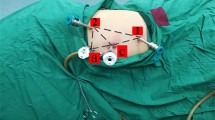Abstract
To demonstrate the safety and efficacy of combine laparoscopy and flexible ureteroscopy to treat ectopic pelvic kidneys with ureteropelvic junction obstruction (UPJO) and stones. 16 patients of ectopic pelvic kidneys with ureteropelvic junction obstruction and stones were treated with laparoscopy and flexible ureteroscopy (FURS). The operative time, required dose of tramadol, visual analog pain scale (VAPS), postoperative day, stone-free rates (SFRs), perioperative complications, and serum creatinine were evaluated. The SFRs were evaluated with noncontrasted renal computed tomography (CT). Intravenous pyelography (IVP) and CT scan were used to evaluate the UPJO. Stone-free status was defined as absence of stone fragments in kidney or the size of that is less than 3 mm. Operation time from 118 to 225 min, average time (171 ± 28) min; lithotomy time from 16 to 45 min, average time (32 ± 6) min. Average tramadol required at the first day postoperation was (118 ± 49.6) mg; at the second day was (78 ± 24.8) mg. VAPS score at 24 h (5.0 ± 0.7), VAPS score at 48 h (2.5 ± 0.8). Postoperative day (3.9 ± 0.6) days. Stone-free rate was 100 %. Average serum creatinine was (88.7 ± 24.3) mol/L before surgery and (92.8 ± 21.6) mol/L after surgery. No major complication. No stone and obstruction recurrence in the follow-up of average 29.3 months. Combined FUR and LC is a good option for patient of ectopic pelvic kidney with renal stone and UPJO. From our initial experience, the SFRs and the effect of pyeloplasty are satisfactory and without major complication, the operative time is acceptable.



Similar content being viewed by others
References
Cinman NM, Okeke Z, Smith AD (2007) Pelvic kidney: associated diseases and treatment. J Endourol Soc 21(8):836–842
Alomar M, Alenezi H (2013) Computed tomography-guided transgluteal percutaneous nephrolithotripsy in an ectopic pelvic kidney: novel technique. J Endourol Soc 27(4):398–401
Mehmet RM, Rustu YF, Hanefi B, Mursel D, Fusun A, Mehmet I (2013) Direct pelvic access percutaneous nephrolithotomy in management of ectopic kidney stone: a case report and literature review. Ren Fail 35(10):1440–1444
Elbahnasy AM, Elbendary MA, Radwan MA, Elashry OM, Taha MR (2011) Laparoscopic pyelolithotomy in selected patients with ectopic pelvic kidney: a feasible minimally invasive treatment option. J Endourol Soc 25(6):985–989
Weizer AZ, Springhart WP, Ekeruo WO, Matlaga BR, Tan YH, Assimos DG et al (2005) Ureteroscopic management of renal calculi in anomalous kidneys. Urology 65(2):265–269
Tunc L, Tokgoz H, Tan MO, Kupeli B, Karaoglan U, Bozkirli I (2004) Stones in anomalous kidneys: results of treatment by shock wave lithotripsy in 150 patients. Int J Urol Off J Jpn Urol Assoc 11(10):831–836
Matlaga BR, Kim SC, Watkins SL, Kuo RL, Munch LC, Lingeman JE (2006) Percutaneous nephrolithotomy for ectopic kidneys: over, around, or through. Urology 67(3):513–517
Sheir KZ, Madbouly K, Elsobky E, Abdelkhalek M (2003) Extracorporeal shock wave lithotripsy in anomalous kidneys: 11-year experience with two second-generation lithotripters. Urology 62(1):10–15 (Discussion 15–16)
Küpeli B, Isen K, Biri H, Sinik Z, Alkibay T, Karaoğlan U et al (1999) Extracorporeal shockwave lithotripsy in anomalous kidneys. J Endourol Soc 13(5):349–352
Galvin DJ, Pearle MS (2006) The contemporary management of renal and ureteric calculi. BJU Int 98(6):1283–1288
Grasso M (1996) Experience with the holmium laser as an endoscopic lithotrite. Urology 48(2):199–206
Kourambas J, Byrne RR, Preminger GM (2001) Does a ureteral access sheath facilitate ureteroscopy? J Urol 165(3):789–793
Ito H, Kawahara T, Terao H, Ogawa T, Yao M, Kubota Y et al (2012) The most reliable preoperative assessment of renal stone burden as a predictor of stone-free status after flexible ureteroscopy with holmium laser lithotripsy: a single-center experience. Urology 80(3):524–528
Kanao K, Nakashima J, Nakagawa K, Asakura H, Miyajima A, Oya M et al (2006) Preoperative nomograms for predicting stone-free rate after extracorporeal shock wave lithotripsy. J Urol 176(4 Pt 1):1453–1456 (discussion 1456–1457)
Wiesenthal JD, Ghiculete D, Ray AA, Honey RJD, Pace KT (2011) A clinical nomogram to predict the successful shock wave lithotripsy of renal and ureteral calculi. J Urol 186(2):556–562
Atug F, Castle EP, Burgess SV, Thomas R (2005) Concomitant management of renal calculi and pelvi-ureteric junction obstruction with robotic laparoscopic surgery. BJU Int 96(9):1365–1368
Mufarrij PW, Woods M, Shah OD, Palese MA, Berger AD, Thomas R et al (2008) Robotic dismembered pyeloplasty: a 6-year, multi-institutional experience. J Urol 180(4):1391–1396
Stravodimos KG, Giannakopoulos S, Tyritzis SI, Alevizopoulos A, Papadoukakis S, Touloupidis S et al (2014) Simultaneous laparoscopic management of ureteropelvic junction obstruction and renal lithiasis: the combined experience of two academic centers and review of the literature. Res Rep Urol 6:43–50
Link RE, Bhayani SB, Kavoussi LR (2006) A prospective comparison of robotic and laparoscopic pyeloplasty. Ann Surg 243(4):486–491
Bhayani SB, Link RE, Varkarakis JM, Kavoussi LR (2005) Complete daVinci versus laparoscopic pyeloplasty: cost analysis. J Endourol Soc 19(3):327–332
Kamat N, Khandelwal P (2004) Laparoscopic pyelolithotomy—a technique for the management of stones in the ectopic pelvic kidney. Int J Urol Off J Jpn Urol Assoc 11(7):581–584
Eden CG (2007) Minimally invasive treatment of ureteropelvic junction obstruction: a critical analysis of results. Eur Urol 52(4):983–989
Talic RF (1996) Extracorporeal shock-wave lithotripsy monotherapy in renal pelvic ectopia. Urology 48(6):857–861
Conflict of interest
No conflicts of interest to declare.
Author information
Authors and Affiliations
Corresponding author
Rights and permissions
About this article
Cite this article
Yin, Z., Wei, Y.B., Liang, B.L. et al. Initial experiences with laparoscopy and flexible ureteroscopy combination pyeloplasty in management of ectopic pelvic kidney with stone and ureter–pelvic junction obstruction. Urolithiasis 43, 255–260 (2015). https://doi.org/10.1007/s00240-015-0753-9
Received:
Accepted:
Published:
Issue Date:
DOI: https://doi.org/10.1007/s00240-015-0753-9




